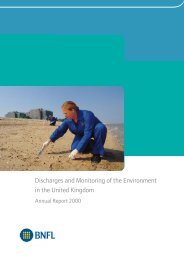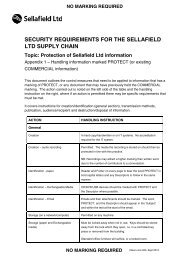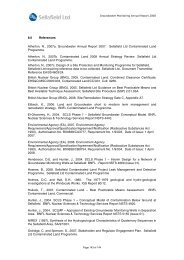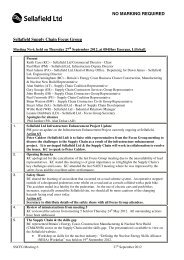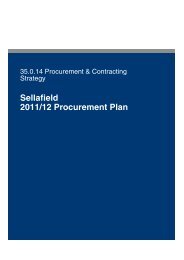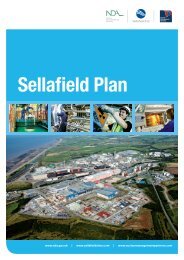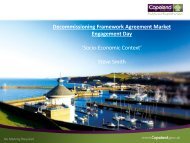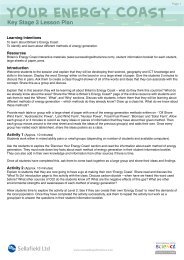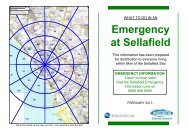Annual Report for 2010/11 and Forward Programme - Sellafield Ltd
Annual Report for 2010/11 and Forward Programme - Sellafield Ltd
Annual Report for 2010/11 and Forward Programme - Sellafield Ltd
Create successful ePaper yourself
Turn your PDF publications into a flip-book with our unique Google optimized e-Paper software.
SSEM/20<strong>11</strong>/4730 June 20<strong>11</strong>technical complications) impact on the ability of the contractor to achieve beach targetareas in any given monitoring block. This year, in response to concerns raised bylocal stakeholders about possible detrimental aspects of beach monitoring operationsduring peak tourist seasons, no monitoring is planned during the Easter (4 weeks)<strong>and</strong> Summer (6 weeks) school holidays. Where monitoring is required during thebuffer time, all ef<strong>for</strong>ts will be made to avoid those beaches with the highest publicoccupancy. Recognising the long summer buffer period, beaches with the highestpublic occupancy rates (St Bees <strong>and</strong> Seascale) are scheduled to be monitored asclose as possible to the start <strong>and</strong> finish of this break. This should mean thatmonitoring takes place at times that are most representative of periods when thebeaches have their highest occupancy, but without the adverse impacts of monitoringwhen large numbers of the public are present.As a result of introducing these repeat visits either side of the buffer periods <strong>and</strong> bybreaking the majority of monitoring periods down into week-long blocks at eachbeach, the number of monitoring visits to St Bees <strong>and</strong> Seascale will be increasedcompared to the <strong>2010</strong>/<strong>11</strong> programme.For 20<strong>11</strong>/12 we are including beach areas from last years’ investigations as namedbeach areas in the programme (Allonby, Whitehaven North <strong>and</strong> Harrington), togetherwith a non-beach specified Investigation period. The specific inclusion of Allonby,Whitehaven North <strong>and</strong> Harrington, recognises the interest in continued monitoring onbeach areas to the north of St Bees where a small number of finds have beenrecovered on some of the previous visits. A decision on how best to allocate theInvestigation period will be made closer to the time. <strong>Sellafield</strong> <strong>Ltd</strong> will consult with theEA on this allocation.To the south of <strong>Sellafield</strong>, beach monitoring has been carried out at Drigg beach eachyear, extending to Drigg Point <strong>and</strong> the Ravenglass estuary. The HPA presentation tothe multi-agency workshop in November <strong>2010</strong> included a recommendation <strong>for</strong>:. Consistent with this recommendation, Driggbeach will be monitored twice during 20<strong>11</strong>/12.We believe the programme is commensurate with the levels of risk as currently assessed<strong>and</strong> is capable of providing reassurance that risks remain very low. The programme fits withthe HPA’s advice <strong>for</strong>, (Cooper, 20<strong>11</strong>). As in previous years, where findings from themonitoring result in the need to review the programme, this will be done in full consultationwith the EA.Week StartingSoftrak Beach MonitoringAreaTargets (ha)4 Apr <strong>Sellafield</strong> (a) 4<strong>11</strong> Apr18 Apr25 AprBuffer Time –2 May9 May <strong>Sellafield</strong> (b) 416 May St Bees (1) 423 May Vehicle Maintenance/Str<strong>and</strong>line© Nuclear Decommissioning Authority 20<strong>11</strong>. 97



